Gospel According To Al Green documentary

After filmmaker Robert Mugge produced BLACK WAX with Gil Scott-Heron for Britain’s new Channel 4 Television in 1982, he and Channel 4’s Commissioning Editor for Music Andy Park wanted to collaborate again. Park suggested Mugge create a portrait of African American gospel star Andraé Crouch. But Mugge, a longtime fan of soul and pop singer Al Green, countered that Green’s rejection of soul music to become a Memphis-based preacher and gospel singer perhaps made him a richer potential subject. Park agreed, though Mugge then needed thirteen months to secure Green’s approval, getting his okay only days before the planned Seventh Anniversary Celebration of Green’s Full Gospel Tabernacle. The Sunday afternoon church service would feature not only Green’s usual church choir and musicians, but also a second choir from Ellington, South Carolina and most of Green’s touring musicians and backup singers. Mugge arranged to document that December 18, 1983 service with three 16mm cameras and a 24-track audio recording truck, making it the first (and reportedly still the only) Al Green church service to be committed to film.
While in Memphis, Mugge and his crew went on to film an interview with legendary Hi Records producer Willie Mitchell who had produced and co-written Green’s commercial hits of the 1970s, a studio rehearsal featuring Green and his musicians, and finally a long interview with Green himself. In Green’s interview, he explored his early days in the music business, his creation of such popular hits as “Tired of Being Alone” and “I Can’t Get Next to You,” the traumatic events that led to his abandoning of his successful soul and pop career, the purchase of the Memphis church building which he transformed into a church of his own, and the ways in which his soul and gospel backgrounds had each informed the other.
Perhaps the most emotional part of Green’s interview was his discussion of the so-called “hot grits incident,” wherein a spurned girlfriend assaulted him in the shower with a pot of boiling hot grits, then ran to another room of his house where she shot and killed herself. This interview, conducted two days after his church service, was the first occasion on which he discussed this experience publicly, and he included facts that even his own band members had never heard.
In February of 1984, Mugge also filmed Green and his band in concert at the Non-commissioned Officers Club of Bolling Air Force Base in Washington, D.C., this time utilizing four 16mm cameras and the same Nashville-based 24-track recording truck he had hired to record the Memphis church service. It should be noted that, at that point in Rev. Green’s career, he had embraced the Southern fundamentalist notion that blues, rhythm ‘n’ blues, and rock ‘n’ roll were “music of the Devil,” and that, therefore, he should now perform only gospel music. However, among the numbers Green performed at the D.C. concert was Curtis Mayfield’s “People Get Ready,” which exists somewhere between soul and gospel. In addition, during the staged rehearsal in Memphis, Green agreed to perform “Let’s Stay Together,” which had been one of his biggest commercial successes and now represented a recurring theme in the film.
Along with fragments of a few more hits he performed during his interview, these songs helped to depict “Al Green the pop star” who had preceded “Al Green the pastor.” While editing the film back in Philadelphia, Mugge also decided to interview writer Ken Tucker who was then chief music critic for the Philadelphia Inquirer. Tucker skillfully summarized Green’s place in the evolution of American soul music and outlined the ongoing conflict between the secular and spiritual sides of pop music, both of which provided welcome context for Green’s unique spiritual journey.
Among the top Memphis musicians who appear in this film are, number one, Lawrence H. “Larry” Lee, Jr., who was best known for touring with Green and for performing at Woodstock and elsewhere with Jimi Hendrix’s Gypsy Sun and Rainbows; and number two, Mabon Lewis “Teenie” Hodges, who co-wrote Green’s hits “Take Me to the River” and “Love and Happiness” and toured and recorded widely as a guitarist with the Hi Records Rhythm Section. Lee can be seen performing in the church service and rehearsal sequences of the film, and Hodges can be heard, and briefly seen, playing incidental guitar behind Green during much of his interview. Sadly, both men are now deceased.
The resulting 96-minute film, GOSPEL ACCORDING TO AL GREEN, had its world premiere presentation in the summer of 1984 at Filmfest Munchen (a film festival in Munich, Germany), its television premiere over Britain’s Channel 4 later that fall, and its U.S. theatrical premiere at Justin Freed’s Coolidge Corner Moviehouse in Brookline, Massachusetts a year later. After each of the two opening night screenings on October 25, 1985, Green sat on the Coolidge Corner stage and, accompanying himself on acoustic guitar, freely offered the commercial hits that he had mostly refused to perform during the making of Mugge’s film, thereby demonstrating his storied unpredictability. Naturally, audience members at both shows were enchanted by his presentation, and since these and other premiere screenings, the film has been in constant release around the world. As to Rev. Green – now Bishop Green – this past December, he and his congregation celebrated the fortieth anniversary of his Full Gospel Tabernacle church.
For MVD Visual’s new worldwide Blu-ray and DVD releases, director Mugge has overseen 4K remastering of the film and created a new 17-minute video titled SOUL AND SPIRIT: Robert Mugge on the Making of GOSPEL ACCORDING TO AL GREEN. Other bonus features include audio of Green’s entire 1983 interview, audio of the climactic final hour of Green’s seventh anniversary church service, an extended film version of a key song from the church service, and the personal telephone answering machine message Green recorded for Mugge in the mid 1980s.
Source: MVD


